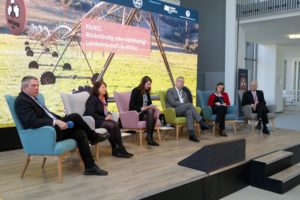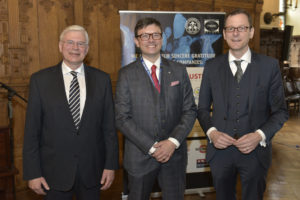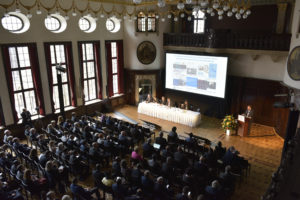Bremen and cotton have been united for more than 200 years. This was confirmed once again, when the 34th International Cotton Conference took place in the historic Town Hall from March 21st to 23rd under the motto “Cotton Insights”. More than 500 participants from 40 countries demonstrated that Bremen, a city of international trade connected to the whole world through its ports, is hugely attractive, especially when it comes to cotton.
With its fringe programme of events, the Cotton Conference has now developed into a multi-faceted ‘cotton week’. The first meetings of the industry organizations ICAC, ITMF and IVGT already took place on Monday and Tuesday, before the official opening. In addition, groups such as DNFI, CICCA, SEEP, IFCP and the ACME met alongside the conference.
SUSTAIN Builds Bridges to the Consumer
 The partnership between the renowned daily newspaper Weser-Kurier as organiser and the Bremen Cotton Exchange, made it possible to impressively bridge the gap to the end consumer with the “SUSTAIN” sustainability conference. The event took place on Tuesday, March 20th with great media coverage, while at the same time imparting objective knowledge about cotton. The main focus was Africa. In the opinion of Fritz A. Grobien, who represented the Cotton Exchange in his function as Vice President and as a cotton trader with experience in Africa, the work with the natural fibre and the possibilities of processing the raw material in cultivating countries provides a great opportunity for development on the African continent. This could lead to job creation and more income. In his speech, Grobien warned against the eco-colonialism of Western countries in Africa against the will of those involved. He also defended his argument with good reason later in the following, tense panel discussion.
The partnership between the renowned daily newspaper Weser-Kurier as organiser and the Bremen Cotton Exchange, made it possible to impressively bridge the gap to the end consumer with the “SUSTAIN” sustainability conference. The event took place on Tuesday, March 20th with great media coverage, while at the same time imparting objective knowledge about cotton. The main focus was Africa. In the opinion of Fritz A. Grobien, who represented the Cotton Exchange in his function as Vice President and as a cotton trader with experience in Africa, the work with the natural fibre and the possibilities of processing the raw material in cultivating countries provides a great opportunity for development on the African continent. This could lead to job creation and more income. In his speech, Grobien warned against the eco-colonialism of Western countries in Africa against the will of those involved. He also defended his argument with good reason later in the following, tense panel discussion.
Challenges and Solutions
 During the following three days, the 34th International Cotton Conference offered a completely revised concept, which was convincing in both the breadth and depth of its subject matter. Visitors were given the opportunity to learn and communicate with each other about the handling of cotton during all the key stages of the cotton value chain, from the cotton field, through processing right up to the retail trade. The goal was to discuss and demonstrate solutions for future challenges at every level. Thus, knowledge of cotton lost in the supply chain could be refreshed. This included clarifying questions on the improvement of cotton quality, as well as topics such as traceability, sustainability, product innovation and, last but not least, the all-embracing subject of digitalisation along the entire supply chain.
During the following three days, the 34th International Cotton Conference offered a completely revised concept, which was convincing in both the breadth and depth of its subject matter. Visitors were given the opportunity to learn and communicate with each other about the handling of cotton during all the key stages of the cotton value chain, from the cotton field, through processing right up to the retail trade. The goal was to discuss and demonstrate solutions for future challenges at every level. Thus, knowledge of cotton lost in the supply chain could be refreshed. This included clarifying questions on the improvement of cotton quality, as well as topics such as traceability, sustainability, product innovation and, last but not least, the all-embracing subject of digitalisation along the entire supply chain.
“Cotton consumption is rising due to the positive development of the global economy and the acceleration of consumer demand for textiles. These are encouraging trends in cotton cultivation. Against this background, the International Cotton Conference provides the opportunity to turn our attention to increasing the use of cotton and to focus on how we can make cotton even more attractive in the eyes of consumers,” said Henning Hammer, President of the Bremen Cotton Exchange in his opening speech at the Cotton Conference.
In addition to the speech by the President of the Cotton Exchange, the opening ceremony began with speeches by the Bremen Senator for Economics, Labour and Ports Martin Günthner and Professor Dr. Axel Herrmann, Director of the Fibre Institute Bremen.
Strong Keynote Session
 Even the keynote session at the beginning of the conference captivated visitors in the packed lecture forum of the Bremen Town Hall. Kai Hughes, Executive Director of the International Cotton Advisory Committee, Washington, presented the ICAC as the driving force behind changes in the cotton industry, on which it is working together with partners in the market, including the Bremen Cotton Exchange. Mark Messura of Cotton Incorporated, Cary, USA, introduced new product ideas for cotton with intelligent properties and benefits for the consumer. Robert Antoshak, Managing Director of the US trading company Olah Inc., warned the proponents of organic cotton growing against the continued demonization of conventional cotton farming methods using arguments that are no longer valid. This endangers the reputation of cotton and could result in the amount of cotton being used in the future being as modest as something like wool in terms of quantity. Consumers are generally more interested in fashion and price when buying clothing. What they are increasingly demanding is transparency concerning the source of the products they have bought. Michael Alt and Eugen Weinberg, commodity analysts at Commerzbank AG, explained the price formation mechanisms for cotton and defused the generally prevailing fear of prices being driven up by commodity futures trading.
Even the keynote session at the beginning of the conference captivated visitors in the packed lecture forum of the Bremen Town Hall. Kai Hughes, Executive Director of the International Cotton Advisory Committee, Washington, presented the ICAC as the driving force behind changes in the cotton industry, on which it is working together with partners in the market, including the Bremen Cotton Exchange. Mark Messura of Cotton Incorporated, Cary, USA, introduced new product ideas for cotton with intelligent properties and benefits for the consumer. Robert Antoshak, Managing Director of the US trading company Olah Inc., warned the proponents of organic cotton growing against the continued demonization of conventional cotton farming methods using arguments that are no longer valid. This endangers the reputation of cotton and could result in the amount of cotton being used in the future being as modest as something like wool in terms of quantity. Consumers are generally more interested in fashion and price when buying clothing. What they are increasingly demanding is transparency concerning the source of the products they have bought. Michael Alt and Eugen Weinberg, commodity analysts at Commerzbank AG, explained the price formation mechanisms for cotton and defused the generally prevailing fear of prices being driven up by commodity futures trading.
Favoured Model Digital Microfactory
The session on digitalisation provided a comprehensive overview of the possibility of steering and controlling processes with the help of mobile devices such as smartphones or iPads via the Internet. An app designed especially for small farms, which accompanies the farmer at all stages of cotton growing and can at the same time be used for training purposes, met with great interest among the conference participants. In addition, there was information on the computerised control of levels of contamination in supplied cotton. Another highlight was the presentation of the model of a digital microfactory.
Quality Cotton for Quality Textiles
Quality plays a decisive role everywhere, especially at the interface between cotton production and trade on the one hand, and spinning mills, weaving mills, equipment and finishing on the other. Cotton quality issues and quality tests are very important. The discussion was based on the results of a global survey that focused on the expectations of spinning, weaving and knitting on the quality properties of cotton.
Much Movement in Traceability
Visitors were especially interested in the subject of cotton traceability. This is due to the fact that buyers of cotton want to know, for example, if their suppliers are complying with promised sustainability criteria. The possibilities and limits of techniques such as DNA tests, fingerprint analysis, marker methods and block-chain processes were discussed here controversially.
Cotton Intelligence Becomes a Subject
The conference also showed that cotton is increasingly being used in technical products. For example, in innovative 3D textiles, in biodegradable composites in the form of nap cores made of cotton and polylactide for use in interior design, or cotton fibre reinforced plastics from micro-injection moulding. These developments make it clear that in addition to clothing production, cotton, because of its properties, is making headway in segments that were previously occupied by synthetic fibres.
Sustainability Must Be Defined
Of course, there were also intensive discussions on the issue of sustainable cotton development. The German Partnership for Sustainable Textiles also plays an active role here. The problem of fallow land: There is still a lack of a globally uniform definition of sustainability for cotton. Thus, a comparison of the measurements of sustainability progress within the cotton industry is only possible to a limited extent. The results of life-cycle analyses vary widely and are very susceptible to error. In many cases, they do not take local and seasonal peculiarities into consideration. Regardless of this, the goal remains of convincing consumers again and again of the sustainability of the raw material cotton. However, when it comes to communication, a format is required that inspires consumers and does not unsettle them.
Conclusion
On behalf of the organisation team, Elke Hortmeyer from the Bremen Cotton Exchange and Axel Drieling from the Fibre Institute Bremen described what makes the International Cotton Conference special: “We have noticed that there is a desire for networking, for discussion and above all for personal discussion and for data and facts.”
“The Bremen Cotton Conference is unique because it brings the diverse world of cotton together in one place. It is always a great opportunity to learn about the latest innovations, talk to cotton merchants and get an overview of the industry,” said Kai Hughes, Executive Director of ICAC, summarising his visit to the meeting.
More Information:
Sources of the Pictures:
Sustain Photo: © Weser-Kurier
Cotton Conference Pictures : © Bremen Cotton Exchange, Fotographs by Mathias Ulrichs

